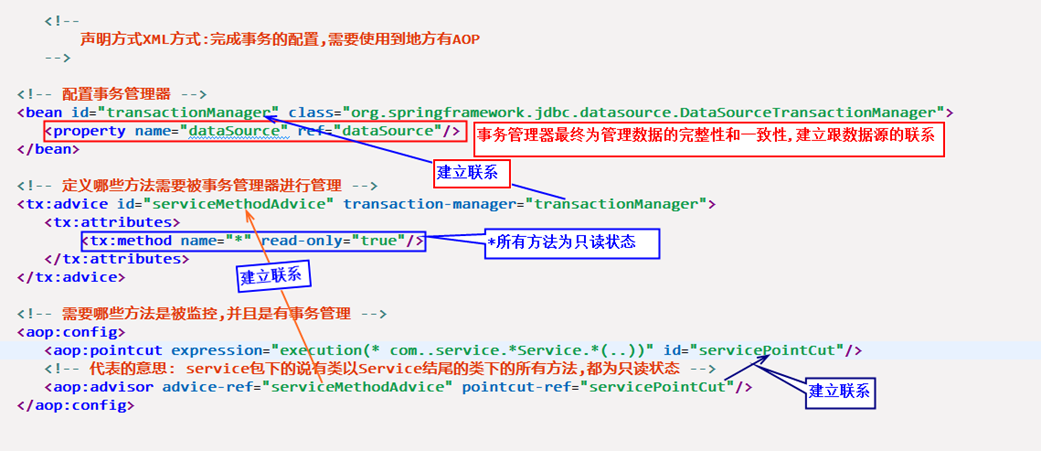第六节 事务XML方式[声明方式]
事务管理: 管理事务,管理数据,数据完整性和一致性
事务[业务逻辑] : 由一系列的动作[查询书价格,更新库存,更新余额],组成一个单元[买书业务],
当我们动作当中有一个错了,全错~
ACID
原子性 隔离性 一致性 持久性
注解方式配置事务[编程方式-->@代码]
1.Spring框架当中需要配置事务管理器--> JDBC[Mybatis] Hibernate JTA-->数据源
2.启动事务注解[特意说了,事务管理器的id]
3.事务注解--> 可以放置的位置:@Transaction 类或者方法上
- 类上放置注解 方法当中注解[reaonly=true]
- rollbakFor
- 传播性 7个 默认值
XML方式配置事务
|
<!-- 声明方式XML方式:完成事务的配置,需要使用到地方有AOP --> <!-- 配置事务管理器 --> <bean id="transactionManager" class="org.springframework.jdbc.datasource.DataSourceTransactionManager"> <property name="dataSource" ref="dataSource"/> </bean> <!-- 定义哪些方法需要被事务管理器进行管理 --> <tx:advice id="serviceMethodAdvice" transaction-manager="transactionManager"> <tx:attributes> <tx:method name="*" read-only="true"/> </tx:attributes> </tx:advice> <!-- 需要哪些方法是被监控,并且是有事务管理 --> <aop:config> <aop:pointcut expression="execution(* com..service.*Service.*(..))" id="servicePointCut"/> <!-- 代表的意思: service包下的说有类以Service结尾的类下的所有方法,都为只读状态 --> <aop:advisor advice-ref="serviceMethodAdvice" pointcut-ref="servicePointCut"/> </aop:config> |

单元测试,推荐使用断言方式,需要再使用syso的输出方式
|
<!-- 定义哪些方法需要被事务管理器进行管理 --> <tx:advice id="serviceMethodAdvice" transaction-manager="transactionManager"> <tx:attributes> <!-- 约定大于配置 --> <!-- 第一种配置方式 <tx:method name="*" read-only="true"/> <tx:method name="add*" propagation="REQUIRED"/> <tx:method name="insert*"/> <tx:method name="create*"/> <tx:method name="update*"/> <tx:method name="edit*"/> <tx:method name="mod*"/> <tx:method name="change*"/> <tx:method name="del*"/> <tx:method name="remove*"/> <tx:method name="cancel*"/> --> <!-- 第二种配置方式 --> <tx:method name="*" read-only="false" /> <tx:method name="get*" read-only="true"/> <tx:method name="load*" read-only="true"/> <tx:method name="list*" read-only="true"/> <tx:method name="find*" read-only="true"/> <tx:method name="sel*" read-only="true"/> <tx:method name="query*" read-only="true"/> </tx:attributes> </tx:advice> |
在这里胖哥想说的,帮助文档一定要看,有一些事情我强调了很多很多遍,你们不走心,我也无能为力!
|
Again in keeping with Spring's philosophy, the TransactionException that can be thrown by any of the PlatformTransactionManager interface's methods is unchecked (that is, it extends the java.lang.RuntimeException class). Transaction infrastructure failures are almost invariably fatal. In rare cases where application code can actually recover from a transaction failure, the application developer can still choose to catch and handle TransactionException. The salient point is that developers are not forced to do so. The getTransaction(..) method returns a TransactionStatus object, depending on a TransactionDefinition parameter. The returned TransactionStatus might represent a new transaction, or can represent an existing transaction if a matching transaction exists in the current call stack. The implication in this latter case is that, as with Java EE transaction contexts, a TransactionStatus is associated with a thread of execution. The TransactionDefinition interface specifies:
|
|
重点: 绝对是个人的建议 RuntimeException默认是不受审查,也是rollBackFor的默认值,如果你再Service层或者Dao层对其进行捕获的话,那么一定要做处理 个人的建议为: service和Dao不管遇到什么请求你都处理往外抛, 处理都放置在Controller 关于异常尽量都是用继承RuntimeException,根据你的代码情况进行不同异常的封装 |
今天的笔记做的不好! 累了!~~~ 付出的越多!~~~ 有的时候失望越多!~~~ 该何去何从!~~~~
第六节 事务XML方式[声明方式]的更多相关文章
- Spring中事务的XML方式[声明方式]
事务管理: 管理事务,管理数据,数据完整性和一致性 事务[业务逻辑] : 由一系列的动作[查询书价格,更新库存,更新余额],组成一个单元[买书业务], 当我们动作当中有一个错了,全错~ ACID 原子 ...
- ES6第二节:新的声明方式
通过上一节的环境搭建完成,接下来我们就可以愉快的探索ES6的新世界了!下面我们从新的声明方式开始: 在ES6里新加了两种声明方式:let 和 const,以前我们都是用var去作声明,接下来我们一一比 ...
- 【系统学习ES6】第一节:新的声明方式
[系统学习ES6] 本专题旨在对ES6的常用技术点进行系统性梳理,帮助大家对其有更好的掌握.计划每周更新1-2篇,希望大家有所收获. 以前用ES5时,声明变量只能用var.ES6的出现,为我们带来了两 ...
- 第六节:WebApi的部署方式(自托管)
一. 简单说明 开篇就介绍过WebApi和MVC相比,其中优势之一就是WebApi可以不依赖于IIS部署,可以自托管,当然这里指的是 .Net FrameWork 下的 WebApi 和 MVC 相比 ...
- ASP.NET MVC深入浅出系列(持续更新) ORM系列之Entity FrameWork详解(持续更新) 第十六节:语法总结(3)(C#6.0和C#7.0新语法) 第三节:深度剖析各类数据结构(Array、List、Queue、Stack)及线程安全问题和yeild关键字 各种通讯连接方式 设计模式篇 第十二节: 总结Quartz.Net几种部署模式(IIS、Exe、服务部署【借
ASP.NET MVC深入浅出系列(持续更新) 一. ASP.NET体系 从事.Net开发以来,最先接触的Web开发框架是Asp.Net WebForm,该框架高度封装,为了隐藏Http的无状态模 ...
- android解析xml文件的方式
android解析xml文件的方式 作者:东子哥 ,发布于2012-11-26,来源:博客园 在androd手机中处理xml数据时很常见的事情,通常在不同平台传输数据的时候,我们就可能使用xm ...
- 第一百二十六节,JavaScript,XPath操作xml节点
第一百二十六节,JavaScript,XPath操作xml节点 学习要点: 1.IE中的XPath 2.W3C中的XPath 3.XPath跨浏览器兼容 XPath是一种节点查找手段,对比之前使用标准 ...
- spring,springmvc,mybatis基本整合(一)--xml文件配置方式(1)
**这个整合.仅仅是最主要的整合,而且是xml配置文件的方式之中的一个,即当中的mybatis是採用非mapper接口的方式.(第二遍採用mapper接口方式.第三遍採用注解的方式:第四篇採用注解基于 ...
- MVVM模式解析和在WPF中的实现(六) 用依赖注入的方式配置ViewModel并注册消息
MVVM模式解析和在WPF中的实现(六) 用依赖注入的方式配置ViewModel并注册消息 系列目录: MVVM模式解析和在WPF中的实现(一)MVVM模式简介 MVVM模式解析和在WPF中的实现(二 ...
随机推荐
- Arcgis安装要素
1. ArcGIS安装过程中需将用户名改为计算机名,该计算机名称时需要新建对话框. 2. ArcGIS Server安装过程中要设置ArcGISWebServices用户的读写权限,即设置ASP.NE ...
- Java中Class类详解、用法及泛化
Java中Class类及用法 Java程序在运行时,Java运行时系统一直对所有的对象进行所谓的运行时类型标识,即所谓的RTTI.这项信息纪录了每个对象所属的类.虚拟机通常使用运行时类型信息选准正确方 ...
- mongodump备份小量分片集群数据
1.使用mongodump备份小量分片集群数据 如果一个分片集群的数据集比较小,可以直接使用mongodump连接到mongos实例进行数据备份.默认情况下,mongodump到非primary的节点 ...
- OD之去除nag弹窗(四)
在某些方面,一个软件如果没有注册的话,老是会弹出烦人的注册弹窗,就如下图一样: 出现了两次弹窗,开始一次,关闭后又一次,老办法,拖进OD进行分析;不过看出程序很简单,就出现了messagebox的调用 ...
- PAT甲题题解-1095. Cars on Campus(30)-(map+树状数组,或者模拟)
题意:给出n个车辆进出校园的记录,以及k个时间点,让你回答每个时间点校园内的车辆数,最后输出在校园内停留的总时间最长的车牌号和停留时间,如果不止一个,车牌号按字典序输出. 几个注意点: 1.如果一个车 ...
- sql 更新多条记录
转载:https://www.cnblogs.com/hfultrastrong/p/6905057.html 如果你想更新多行数据,并且每行记录的各字段值都是各不一样,你会怎么办呢?本文以一个示例向 ...
- 浅谈FPGA
浅谈FPGA 前言 生活中永远都不会缺少「 为什么 」,于最近就被合胜学长了,问了一个看似简单却又极具意义的问题,为什么需要FPGA?FPGA与单片机的区别是什么?瞬间刷新了我入门三天FPGA的冲击感 ...
- 团队伊始——DreamCatcher
我们的团队,队名是DreamCatcher,中文意思是追梦人,它是一首歌曲,所属专辑是<新世纪的曙光>. 这是一首很好听的歌曲,里面有一句歌词是: I'm a dream catcher ...
- JAVA面对对象(一)——封装
1.封装思想:将对象的属性和行为封装起来的载体是类,类通常对客户隐藏其实现的细节 2.封装就是将属性私有化(private),并提供公共的方法(public)访问私有属性 3.通过封装,实现对属性数据 ...
- VSCODE 使用gitlab 推送代码的简单总结
1. 前提条件: 有一个gitlab 服务器 自己的windows机器上面已经形成了 ssh key 以及进行了 gitlab global config 的配置 能够正常联系gitlab数据库 2. ...
